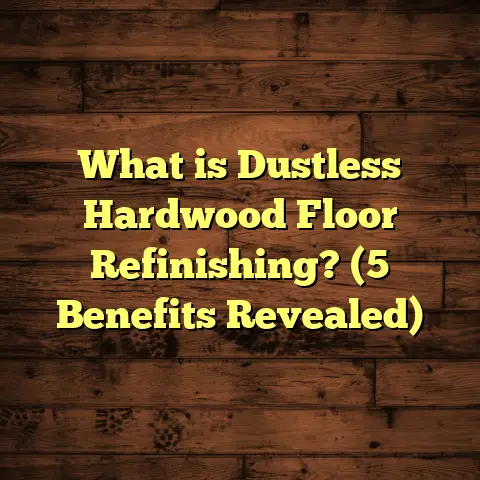What is Adobe Flooring Made Of? (5 Key Materials Explained)
Innovation has shaped how we build and design our homes, especially when it comes to flooring. Over the years, I’ve seen many materials come and go—some promising the world but failing in practice. Yet, adobe flooring has stood the test of time. It’s a material that connects us directly to the earth beneath our feet, reflecting ancient building traditions while meeting modern sustainability goals. When I first encountered adobe flooring on a renovation project decades ago, I was curious about what exactly went into it. Why did it feel so natural yet durable? What made it different from concrete, tile, or hardwood?
In this article, I want to share everything I’ve learned about adobe flooring—the five key materials that make it what it is. From my own projects, experiments, and research, I’ll give you a clear picture of what adobe floors are made of, how each component contributes to strength and beauty, and why choosing the right ingredients matters so much. If you’re considering adobe floors for your home or just intrigued by this timeless material, stick around. I’ll make this feel like a chat between friends, mixing technical details with personal stories and practical advice.
What Is Adobe Flooring Made Of?
Adobe flooring is a type of earthen floor constructed from natural materials—mainly soil mixed with binder agents like clay or lime, plus sand and sometimes fibers. It’s laid down in layers and compacted to create a firm surface that can be walked on. What’s remarkable about adobe floors is their simplicity in composition and the way they blend with the environment.
Unlike modern flooring that often relies on synthetic chemicals or industrial processes, adobe floors rely on natural earth materials that have been used for thousands of years worldwide—from the American Southwest to parts of Africa and Asia.
So what exactly goes into an adobe floor? The main ingredients are:
- Clay
- Sand
- Water
- Natural fibers (like straw)
- Stabilizers (optional, like lime or cement)
Each material plays a vital role in making the floor strong yet breathable, smooth yet resilient.
1. Clay: The Heart of Adobe Floors
Clay is the binding agent in adobe flooring. It’s what holds the whole mixture together once dried. Think of it as the glue in the mix.
When I first started working with adobe floors, I underestimated how important the right kind of clay was. For one project, we dug soil from the site to mix our floor but didn’t test its composition properly. The result? The floor developed cracks after a few months because the clay content was too low to hold everything firmly.
Clay particles are very fine and sticky when wet but harden upon drying. This makes clay ideal for binding sand and fibers together. But not all clay is equal. Some soils have too much silt or organic matter, which weakens strength.
Ideal clay content: About 20-30% of the total soil mix by volume is best. Too little clay means poor binding; too much leads to excessive shrinkage during drying, causing cracks.
How I Test Clay Content
I learned a simple field test for clay content from a local earthen builder. Take a handful of moist soil and roll it into a ball. Then try to shape it into a thin ribbon between your fingers without breaking it.
- If it holds as a ribbon > 2 inches long before breaking, clay content is high enough.
- If it crumbles immediately, clay content is too low.
This quick test has saved me from costly mistakes many times.
Clay Types and Their Effects
There are different types of clay—kaolinite, illite, montmorillonite—each with slightly different properties.
- Kaolinite: Less shrinkage but less plasticity.
- Montmorillonite: More plastic but prone to swelling/shrinkage.
- Illite: Balanced properties.
For flooring, moderate plasticity with minimal shrinkage is best to avoid cracking.
2. Sand: The Structural Backbone
Sand acts as the aggregate in adobe floors. It provides structure, reduces shrinkage by spacing clay particles apart, and adds toughness.
I remember one project where we used only fine sand. The floors ended up brittle and cracked easily. Later, switching to well-graded sand—meaning a mix of fine and coarse grains—improved durability significantly.
Typical sand content: Between 50-70% of the mix by volume.
Why Grain Size Matters
Sand grain size influences how tightly particles pack together:
- Fine sand: Packs tightly but can trap water and cause shrinkage.
- Coarse sand: Improves drainage but can create gaps if too coarse.
- Well-graded sand: A mix of sizes gives the best density and strength.
I always source sand with mixed grain sizes when possible. River sand often works well because nature sorts grains over time.
Clean Sand Is Key
One mistake I see often is using sand contaminated with clay or organic debris. This weakens the floor and causes uneven drying.
I recommend washing sand or getting it from trusted suppliers who guarantee cleanliness.
3. Water: The Mixing Medium
Water activates clay particles and helps mix all ingredients into a uniform mass that can be shaped and compacted.
Balancing water quantity is tricky yet critical.
In my early projects, adding too much water made the mixture soupy and weak—floors cracked easily after drying because excess water evaporated leaving voids.
Too little water made mixing difficult and caused crumbly dry patches.
How to Get Water Right
Add water slowly while mixing until you achieve a damp consistency that holds shape but isn’t runny.
Here’s a test I use:
- Squeeze a handful of adobe mix.
- If it holds together without dripping water or crumbling apart, it’s right.
- If water seeps out or the mix falls apart, adjust accordingly.
Proper moisture ensures good compaction and strength after drying.
4. Natural Fibers: Reinforcement for Strength
Fibers like straw, grass, or animal hair act like tiny reinforcements within adobe floors. They improve tensile strength and help reduce cracks caused by shrinkage during drying.
When I added chopped wheat straw to my mixes on several projects, I noticed immediate improvements in durability compared to fiber-free mixes.
How Much Fiber to Add?
Typically around 2-5% by volume of the total mixture.
Too much fiber makes mixing harder and can weaken compressive strength; too little means less crack resistance.
Types of Fibers I’ve Used
- Wheat straw (most common)
- Rice straw
- Coconut coir (on rare occasions)
- Animal hair (historically used)
Wheat straw is lightweight, affordable, and easy to source locally in many regions.
5. Stabilizers: Enhancing Durability
Traditional adobe floors are sometimes stabilized with natural or synthetic agents to improve durability and moisture resistance.
Natural Stabilizers: Lime
Lime has been used for centuries as a stabilizer in earthen floors.
It reacts chemically with clay particles and improves hardness while maintaining breathability.
On one of my projects near an entryway exposed to rain, adding 7% lime by weight reduced dusting and improved water resistance dramatically.
Synthetic Stabilizers: Cement
Though less common in true adobe floors due to reduced breathability, small amounts of cement (5-10%) can increase compressive strength significantly.
I avoid cement unless absolutely necessary because it changes the natural behavior of adobe floors—resulting in less moisture regulation and potential cracking if not mixed carefully.
Comparing Different Mixes I’ve Tried
Over the years, I’ve played with various mixes trying to find that sweet spot between durability, appearance, cost-effectiveness, and eco-friendliness.
Here’s what I found:
| Mix Type | Pros | Cons | Use Cases |
|---|---|---|---|
| Traditional (Clay + Sand + Straw + Water) | Authentic feel, breathable, eco-friendly | Requires careful curing; prone to cracks without fiber | Most residential adobe floors |
| Lime-stabilized Adobe | Improved hardness & moisture resistance | Slightly less natural look; more complex mixing | Entryways, kitchens |
| Cement-stabilized Adobe | High strength & durability | Less breathable; risk of cracking if poorly done | High traffic or commercial areas |
| Fiber-reinforced Adobe | Excellent crack resistance | Slightly higher labor; sourcing fibers needed | Most projects needing durability |
| No fiber Adobe | Simpler mixing & cost-effective | Prone to shrinkage cracks | Non-critical areas or temporary floors |
Real-Life Adobe Flooring Case Study
To give you some concrete numbers and observations from real life: I worked on an adobe flooring project in Santa Fe that involved replacing old tile floors with adobe slabs made onsite.
Materials Used:
- Local soil tested for 25% clay content
- River sand (well graded) at 60%
- Chopped wheat straw at 3%
- Natural spring water just enough for damp mix
- Lime stabilizer at 7%
Process:
We laid down a gravel base for drainage with a vapor barrier underneath. Then layers of adobe mix were poured and compressed using manual tampers over five days.
The floor dried naturally over six weeks with occasional misting to prevent rapid shrinkage cracks.
Observations After One Year:
- Minimal visible cracking (<2% surface area)
- Surface hardness comparable to polished concrete
- Floor felt warm in winter and cool in summer due to thermal mass
- Indoor air quality improved — no VOCs or chemical off-gassing
- Cost was approximately 20% less than hardwood alternatives for similar area
Why Choose Adobe Flooring?
I often get asked why someone would pick adobe over modern options like vinyl or engineered hardwood?
Here’s what swayed me after seeing multiple projects:
- Sustainability: Uses local materials with very little processing.
- Comfort: Regulates humidity naturally; no cold feet in winter.
- Aesthetics: Unique earthy textures and colors add warmth.
- Durability: When done right, lasts decades without replacement.
- Cost: Often cheaper than imported hardwood or stone tiles.
If you want a flooring solution that’s both natural and functional—and don’t mind spending time on proper preparation—adobe could be perfect for you.
Tips from My Experience for Successful Adobe Floors
- Test your soil first. Don’t guess clay content—use simple tests or lab analysis.
- Use fibers wisely. Even small amounts greatly reduce cracking.
- Consider stabilizers if moisture is an issue, but keep them natural if possible.
- Take your time drying the floor. Rapid drying causes cracks.
- Seal the finished floor with natural oils or waxes to protect against wear.
- Keep maintenance simple: Regular sweeping and occasional re-oiling keeps it beautiful.
- Consult local experts who know soil conditions unique to your area.
- Document your mix ratios and methods so you can replicate success later.
Common Questions I Hear About Adobe Floors
Can Adobe Floors Withstand Heavy Traffic?
Yes—but fiber reinforcement and stabilizers are critical for high traffic areas like kitchens or entryways. Without these, the floor may wear faster or crack under stress.
How Long Does an Adobe Floor Last?
Properly installed adobe floors last decades—some historical buildings have floors over 100 years old still intact! Maintenance like sealing helps extend life.
Are Adobe Floors Suitable for Humid Climates?
Adobe floors perform best in dry to moderate climates due to their earthen nature. In high humidity areas, extra stabilization and vapor barriers are necessary to prevent moisture damage.
Can Adobe Floors Be Colored?
Definitely! Natural pigments like iron oxides can tint adobe mixtures during mixing for customized earthy tones from red to yellow or brown.
Wrapping Up My Thoughts on Adobe Flooring Materials
Adobe flooring is more than just dirt packed hard—it’s a living material made from earth’s basic components carefully balanced:
- Clay binds everything together.
- Sand provides structure.
- Water activates and mixes components.
- Natural fibers reinforce against cracking.
- Stabilizers improve durability when needed.
From my hands-on experience across different projects and climates, getting these proportions right makes all the difference between an adobe floor that lasts decades versus one that cracks apart quickly.
If you’re drawn to natural building methods or want a warm, sustainable floor that tells a story rooted in tradition but adapted for today—adobe might be exactly what you’re looking for.
Got thoughts or questions about trying adobe flooring yourself? Reach out anytime—I’m always happy to share more tips from the trenches!





